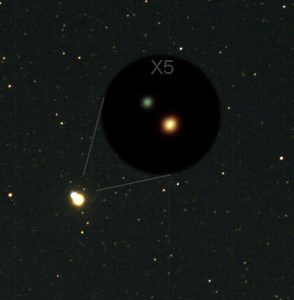2023 January 1
Albireo Unbound
Deep Sky Note #3

It has long been a matter of heated contention whether this gorgeous double star is a physical binary or merely a chance line-of-sight alignment, and you’ll find all sorts of conflicting statements made on the subject in recent books and on current websites. Neither of the modern astrometric satellite observatories HIPPARCOS or GAIA have yet managed to settle the matter definitively, although their parallax determinations for the two stars do suggest a difference in distance of anything up to 30 light years, well below which the two could not possibly be coupled together in a binary. The transverse separation projected on ‘the plane of the sky’ is 0.07 light years or 4440 times the Sun-Earth distance but that is obviously only a lower limit to what it could possibly be and the actual separation may be far larger: as yet, we just don’t know.
However, despite that, there is now sufficient data available to do a dynamical test (rather than a merely astrometric one) of whether the two stars can possibly be gravitationally bound to each other, a fact which does not seem to have been generally noticed (and only a couple of days ago I came across a webpage by a professor in my own university devoted to Albireo as a classic case of a visual binary, which latter at least it most certainly is not! But said professor is clearly not a practical, i.e. observational, astronomer). I’ve been reviewing the latest available relevant data this week, and doing some simple 2-body dynamics with it, with the following results:
The relative velocity (i.e. ‘internal’ velocity within the AB pair, discounting any shared common motion) of the two stars Albireo A and Albireo B is 6.7 km/sec to about +/- 0.1 km/sec, while assuming the extreme case most favourable to their being bound together by their mutual gravitation – that is, that they have zero separation along the line of sight (extremely improbable) and are therefore ‘only’ 4440 A.U. apart – and combining that with the best estimates of the stellar masses in a calculation which is essentially the 2-body fully generalized dynamical form of Kepler’s 3rd Law, the equivalent escape velocity of A and B from that least-possible separation is only 2.15 km/sec at most, again +/- about 0.1.
Conclusion: Albireo A & B cannot possibly be gravitationally bound to each other even if they are at exactly the same distance from us – so we don’t actually need to wait for GAIA to pin down the two distances finally, to settle the matter. This conclusion holds by a very large safety-margin and so is robust in the face of remaining uncertainties of data. It didn’t at all have to be so but, as it turns out, it is. To put that in the relevant dynamical terms, to ‘bind’ A & B gravitationally at that least-possible 4440 A.U. would require approximately 9.4 times their known total mass, making that of the combined A+B ‘system’ 109 solar masses – completely out of the question by a factor of at least 5.
Albireo is not a binary star – case closed!
| The British Astronomical Association supports amateur astronomers around the UK and the rest of the world. Find out more about the BAA or join us. |
